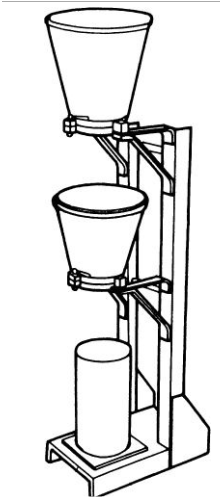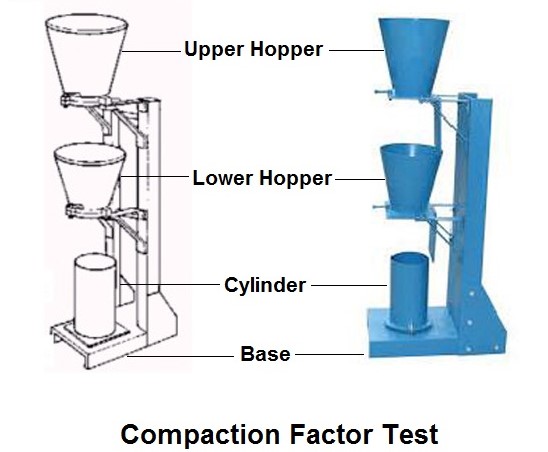There is no generally accepted method of directly measuring the amount of work necessary to achieve full compaction, which is a definition of workability. Probably the best test yet available uses the inverse approach: the degree of compaction achieved by a standard amount of work is determined.
The work applied includes perforce the work done against the surface friction but this is reduced to a minimum, although probably the actual friction varies with the workability of the mix.
The degree of compaction, called the compacting factor, is measured by the density ratio, i.e. the ratio of the density actually achieved in the test to the density of the same concrete fully compacted.
The test, known as the compacting factor test, is described in BS 1881-103 : 1993 and in ACI 211.3-75 and is appropriate for concrete with a maximum size of aggregate up to 40 mm.
The apparatus consists essentially of two hoppers, each in the shape of a frustum of a cone, and one cylinder, the three being above one another. The hoppers have hinged doors at the bottom, as shown in Fig. 1. All inside surfaces are polished to reduce friction.

The upper hopper is filled with concrete, this being placed gently so that at this stage no work is done on the concrete to produce compaction. The bottom door of the hopper is then released and the concrete falls into the lower hopper. This is smaller than the upper one and is, therefore, filled to overflowing, and thus always contains approximately the same amount of concrete in a standard state; this reduces the influence of the personal factor in filling the top hopper. The bottom door of the lower hopper is then released and the concrete falls into the cylinder. Excess concrete is cut by two floats slid across the top of the mould, and the net mass of concrete in the known volume of the cylinder is determined.
The density of the concrete in the cylinder is now calculated, and this density divided by the density of the fully compacted concrete is defined as the compacting factor. The latter density can be obtained by actually filling the cylinder with concrete in four layers, each tamped or vibrated, or alternatively calculated from the absolute volumes of the mix ingredients. The compacting factor can also be calculated from the reduction in volume that occurs when a defined volume of partially compacted concrete (by passing through the hoppers) is fully compacted.
The compacting factor apparatus shown in Fig. 1 is about 1.2 m high and its use is generally limited to pavement construction and precast concrete manufacture.
Table 1 lists values of the compacting factor for different workabilities. Unlike the slump test, variations in the workability of dry concrete are reflected in a large change in the compacting factor, i.e. the test is more sensitive at the low workability end of the scale than at high workability. However, very dry mixes tend to stick in one or both hoppers and the material has to be eased gently by poking with a steel rod. Moreover, it seems that for concrete of very low workability the actual amount of work required for full compaction depends on the richness of the mix while the compacting factor does not.
Leaner mixes need more work than richer ones. This means that the implied assumption that all mixes with the same compacting factor require the same amount of useful work is not always justified. Likewise, the assumption, mentioned earlier, that the wasted work represents a constant proportion of the total work done regardless of the properties of the mix is not quite correct. Nevertheless, the compacting factor test undoubtedly provides a good measure of workability.
Table 1. Description of Workability and Compacting Factor
Read More

